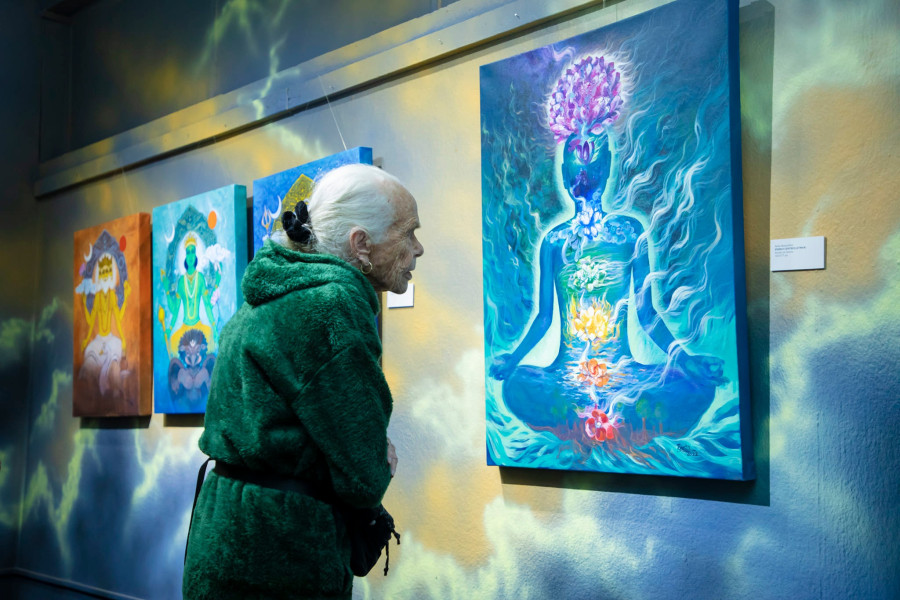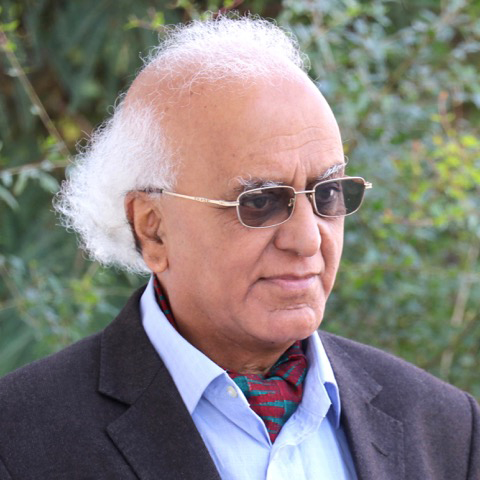Columns
Of private art collections and deities
‘Deities of Nepal’ effectively dramatises Nepali artists’ imaginaire about divine motifs.
Abhi Subedi
An exhibition of artworks under the rubric "Deities of Nepal" was held at the Nepal Art Council, Babarmahal from November 28 to December 11. In an invitation sent to me, Lumbini University academic Swosti Kayastha had stressed the volume and importance of the exhibition. Its motif sounded religious. But in Nepali art, we are familiar with the crisscrossing of themes. I could easily imagine what kind of artworks would be on display. The title evokes a familiar character of the Nepali paintings made on religious motifs. The exhibition was actually meant to embody both challenging and revealing experiences of the contact zones where religious themes are treated with the free spirit of the artists. An appendix added to the invitation says several of the artworks were culled from “private collections”. The temptation to visit the exhibition, therefore, was irresistible.
An exhibition of artworks culled from various sources and collections is nothing new. I recall some important exhibitions of artworks borrowed from private collections. Sangeeta Thapa, director of the Siddhartha Art Foundation, had used different galleries besides her own for such exhibitions. The Arts Council was one of them. It is difficult to find out anything about people's private collections. I have some experience seeing such private collections which happen only once in a while. I want to allude to some of them.
Past exhibitions
Exhibitions of paintings by Lain Singh Bangdel, Amar Chitrakar, Uttam Nepali and others come to mind. The first one was held at the Nepal Art Council Gallery in April 1991 under the title "Bangdel Fifty Years of His Art: A Retrospective Exhibition". It showed 250 works on two floors. I published a review of that in a journal of the Nepal Academy and other outlets. It can be assumed that many paintings in the Bangdel exhibition came from private collections and different holders. The process of culling the artworks gained momentum because of a historical context involving the Nepal Art Council itself.
Another exhibition was that of the great artist Amar Chitrakar held in September-October 1992. Bangdel and I wrote catalogue articles for the exhibition. My article was entitled "Amar Chitrakar: The Man and the Artist". That catalogue lists, thanks to Sangeeta's arduous efforts, Amar's 24 "paintings within the country" held by famous people and members of the royal family. In that "retrospective exhibition", paintings both from private and other collections nearly filled the walls.
Talking about works culled from private collections, we should also mention the retrospective exhibition of Uttam Nepali ''celebrating 46 years of his creativity'' held in March 2003. Another important exhibition of paintings from private collections should be mentioned here. Sangeeta Thapa had brought some paintings of the famous Indian painter Maqbool Fida Husain from five people's private collections for the exhibition organised to mark his death in 2011.
In March 2017, I was amazed to receive information from the Siddhartha Art Gallery to come see a collection of Nepali Chitrakars’ drawings of Nepali birds as part of the month-long Kathmandu Triennale of international art exhibition. That was an invitation to see a volume of paintings in which drawings of Chitrakars’ ancestors, most prominently those of Rajman Chitrakar, featured prominently. The book entitled Some Birds of Nepal prepared by Brian Hodgson was "especially flown to Nepal for the Kathmandu Triennale through the patronage of Turkish Airlines". And that was "on loan from the Natural History Museum in London”. Another exhibition of Chitrakars' paintings also culled from private collections was held in Kathmandu.
I was very happy to see the crowd of young visitors at the exhibition of paintings and sculptures entitled "Deities of Nepal'' at the Nepal Art Council. All the floors were filled with artworks that featured mostly, as the title says, divine motifs. Those works culled from “private collections'' were overtly religious in nature. Govinda Dangol's Pancha Tattva—Genesis of the Supreme Brahman was the first painting that drew my attention. Sushma Shakya's motif of Brahma, Atma and Om done in acrylic comes out well. Then there are Mithila Devi's subtle Maithil work, Sashi Shah's seven stallions, Batsagopal Vaidya's religious motif in acrylic and other mandalic manifestations of other artists.
Maithili works
Sushma Rajbhandari's Ganesh painting captures attention through its brilliant brush strokes and colour combination. So does Ragini Upadhyay's surrealistic painting involving deities and humans locked in tremulous relationships. Similarly, Rajani Sinkhwal's Ganesh in gouache is a good work. Ganesh is the motif of several other paintings. Sauranga Darshandhari's set of three Ganesh in dry points is simple and poetic in its effect. Maithili works of Ajit Shah about the genesis of creation and Deepa Karn's painting “Life of Sita” evoke religious motifs in simple, familiar Maithil idioms.
Tej Bahadur Chitrakar's painting "Lord Shiva in Joyous Mood", acquired from his son artist Madan Chitrakar's collection, is a brilliant work that shows the human power exuded from Parvati's expression. Erina Tamrakar's set of five Shakti images, Sushila Singh's Ashtamatrika on Nepali paper, Sunita Simkhwal's Nrtya Nath Lokeshwor in gouache on cotton canvas, Seema Sharma Shah's etching of Durga and SC Shuman's yellow dominated graphic Shakti are other works that can be cited for illustration. Kalu Kumale's huge tantric sculpture Megasamvara done in copper alloy is a dominating work. That contrasts with Naresh Sainju's small painting of Garuda round the corner upstairs.
This exhibition effectively dramatises Nepali artists' imaginaire about divine motifs.




 18.12°C Kathmandu
18.12°C Kathmandu















